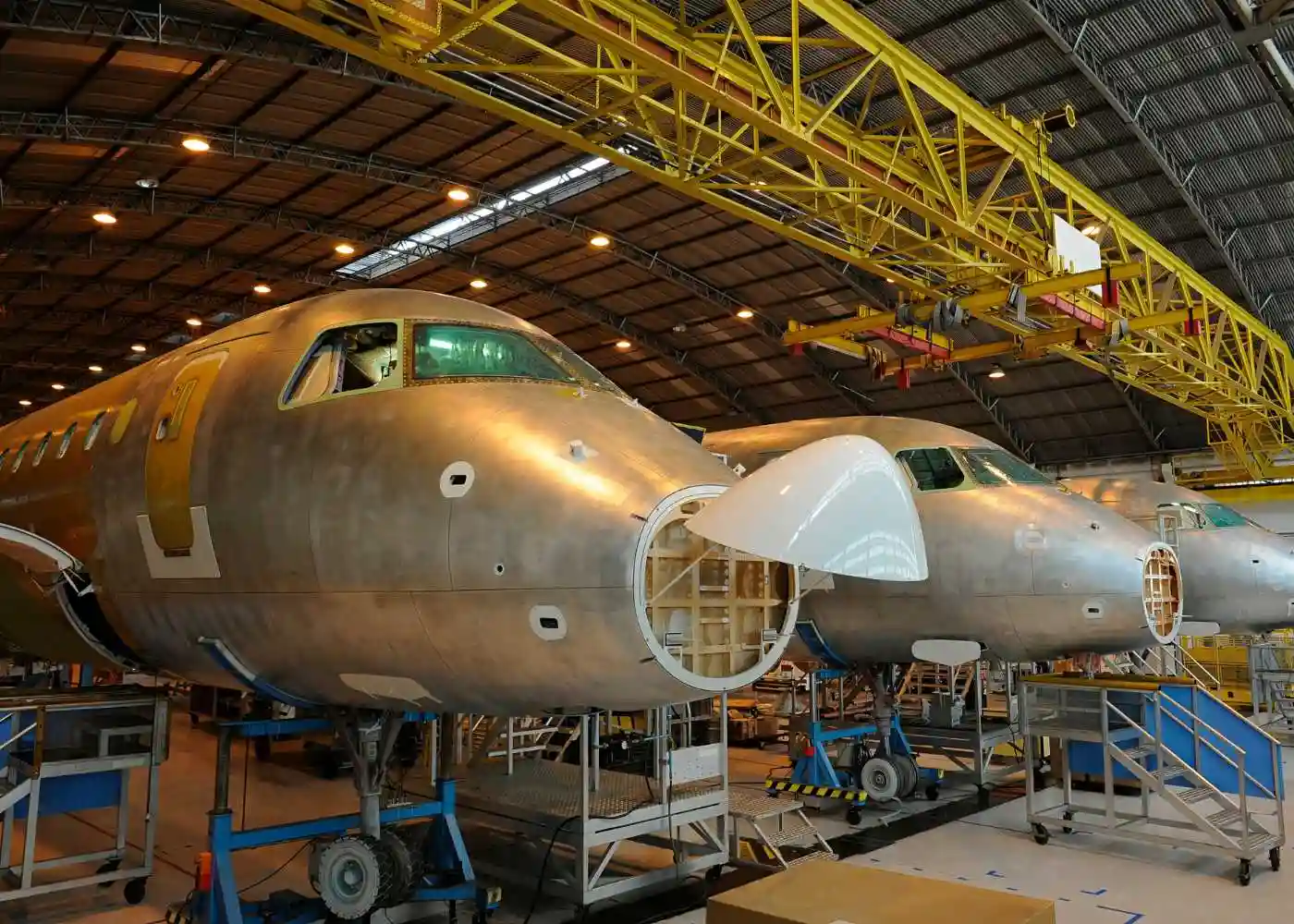The study of Aeronautics and Astronautics is a multidisciplinary field that focuses on the design, development, testing, and operation of aircraft and spacecraft. It is often referred to as Aerospace Engineering. The field encompasses various aspects of engineering, science, and technology, which are applied to the creation and improvement of vehicles and systems that operate in the Earth's atmosphere (aeronautics) and beyond it (astronautics).
Aeronautics primarily deals with the study of aircraft, including their design, manufacturing, and operation. It covers topics such as aerodynamics, propulsion, avionics, flight control systems, and structural design.
Astronautics, on the other hand, focuses on the study of spacecraft, their design, manufacturing, and operation in space. It covers topics such as orbital mechanics, propulsion systems, guidance and control systems, and spacecraft structures and materials.

The study of Aeronautics and Astronautics often involves a combination of theoretical, computational, and experimental methods. Professionals in this field work on a wide range of projects, including the development of commercial aircraft, military planes, rockets, satellites, space probes, and human spaceflight missions.
What does the study of Aeronautics and Astronautics consist of?
The study of Aeronautics and Astronautics, often referred to as Aerospace Engineering, is a broad and multidisciplinary field that encompasses various aspects of engineering, science, and technology related to the design, development, testing, and operation of aircraft and spacecraft. The field consists of several key areas, including:
- Aerodynamics: The study of the motion of air and the forces acting on objects moving through it. This includes understanding how lift, drag, and other forces affect the performance of aircraft and spacecraft.
- Propulsion: The study of systems that generate thrust to propel vehicles through the air or space. This involves designing, developing, and analyzing engines, such as jet engines, turboprops, and rocket engines, as well as alternative propulsion methods like electric propulsion.
- Structures and Materials: The study of the design, fabrication, and properties of materials used in aircraft and spacecraft structures. This includes understanding the stress, strain, and failure mechanics of materials and components, as well as developing lightweight and durable materials.
- Avionics and Control Systems: The study of electronic systems and components used for communication, navigation, and control in aerospace vehicles. This includes the design and development of flight control systems, guidance and navigation systems, and sensors.
- Orbital Mechanics and Astrodynamics: The study of the motion of objects in space, including spacecraft, planets, and other celestial bodies. This involves understanding and predicting orbital trajectories, as well as planning and executing space missions.
- Spacecraft Systems and Design: The study of the various subsystems that make up a spacecraft, such as power generation, thermal control, life support, and communication systems, and how they are integrated into a functional vehicle.
- Aircraft and Spacecraft Manufacturing: The study of techniques and processes used to fabricate, assemble, and test aerospace vehicles and their components, focusing on efficiency, quality, and safety.
- Human Factors and Crew Systems: The study of how human beings interact with aerospace vehicles and systems, including the design of ergonomic and safe environments for pilots, astronauts, and passengers.
- Flight Testing and Validation: The process of testing and validating the performance, safety, and reliability of aircraft and spacecraft during the design, development, and certification stages.
- Aerospace Policy and Management: The study of regulations, policies, and management practices governing the aerospace industry, including safety, environmental, and economic considerations.
These areas often overlap, and professionals in the field of Aeronautics and Astronautics work on a wide range of projects, such as designing and developing commercial aircraft, military planes, satellites, space probes, and human spaceflight missions.

What are the benefits of studying Aeronautics and Astronautics in the U.S.?
Studying Aeronautics and Astronautics in the U.S. offers several benefits, making it an attractive destination for students and professionals interested in pursuing a career in aerospace engineering. Some of the benefits include:
- World-class educational institutions: The U.S. is home to many top-ranked universities and research institutions that offer undergraduate, graduate, and doctoral programs in Aeronautics and Astronautics. These institutions are known for their rigorous curricula, experienced faculty, and state-of-the-art research facilities.
- Cutting-edge research: The U.S. has a strong tradition of research and innovation in aerospace engineering. Many American universities and research centers are at the forefront of advancements in aeronautics and astronautics, providing students with opportunities to work on groundbreaking projects and gain hands-on experience.
- Diverse opportunities: The U.S. aerospace industry is diverse and includes various sectors, such as commercial aviation, defense, space exploration, and satellite technology. This diversity offers students and professionals a wide range of opportunities to specialize and find fulfilling careers in different areas of the field.
- Networking and collaboration: Studying in the U.S. allows students to interact with peers, faculty, and industry professionals, creating valuable networking opportunities. Many universities have strong ties with aerospace companies and government organizations, which can lead to internships, research projects, and job opportunities.
- Strong job market: The U.S. aerospace industry is a significant contributor to the country's economy and offers a robust job market for aerospace engineers. Many leading aerospace companies, such as Boeing, Lockheed Martin, Northrop Grumman, and SpaceX, are based in the U.S., offering a range of career opportunities for graduates.
- Global impact: The U.S. plays a crucial role in global aerospace endeavors, including commercial aviation, military operations, and space exploration. Studying Aeronautics and Astronautics in the U.S. can provide an opportunity to contribute to projects and missions that have a global impact and shape the future of air and space travel.
Overall, studying Aeronautics and Astronautics in the U.S. offers a high-quality education, access to cutting-edge research, diverse opportunities, and strong career prospects, making it an appealing choice for those interested in pursuing a career in aerospace engineering.
What colleges and universities in the U.S. have strong Aeronautics and Astronautics programs?
There are several colleges and universities in the U.S. known for their strong Aeronautics and Astronautics programs. Many of these institutions are highly regarded for their research, faculty, facilities, and industry connections. Some notable schools with well-respected aerospace engineering programs include:
- Massachusetts Institute of Technology (MIT) – Cambridge, MA
- California Institute of Technology (Caltech) – Pasadena, CA
- Stanford University – Stanford, CA
- University of Michigan – Ann Arbor, MI
- Georgia Institute of Technology (Georgia Tech) – Atlanta, GA
- University of Illinois at Urbana-Champaign – Urbana, IL
- University of Texas at Austin – Austin, TX
- Purdue University – West Lafayette, IN
- University of California, Los Angeles (UCLA) – Los Angeles, CA
- University of California, San Diego (UCSD) – La Jolla, CA
- University of Maryland – College Park, MD
- Texas A&M University – College Station, TX
- Virginia Tech – Blacksburg, VA
- University of Colorado Boulder – Boulder, CO
- University of Florida – Gainesville, FL
These institutions offer a variety of undergraduate, graduate, and doctoral programs in aerospace engineering, covering various aspects of Aeronautics and Astronautics. The programs typically involve a combination of theoretical, computational, and experimental coursework, as well as opportunities for research projects, internships, and industry collaboration. Prospective students should research individual programs to determine the best fit for their interests and career goals.
What community colleges have strong Aeronautics and Astronautics programs?
Community colleges can offer a great starting point for students interested in pursuing Aeronautics and Astronautics. Many community colleges provide associate degrees or certificate programs related to aerospace engineering, which can be transferred to a four-year institution to complete a bachelor's degree. Here are a few community colleges in the U.S. with strong Aeronautics and Astronautics-related programs:
- Broward College - Fort Lauderdale, FL: Offers an Associate of Science (A.S.) degree in Aviation Maintenance Management and Aviation Administration, as well as several certificate programs in aviation maintenance technology.
- College of the Canyons - Santa Clarita, CA: Offers an Associate of Science (A.S.) degree in Aviation Maintenance Technology and Aviation Management, as well as certificate programs in aviation maintenance.
- Orange Coast College - Costa Mesa, CA: Offers an Associate of Science (A.S.) degree in Aviation Science, with an emphasis on professional pilot, aviation management, or aviation maintenance.
- Salt Lake Community College - Salt Lake City, UT: Offers an Associate of Applied Science (A.A.S.) degree in Aviation Maintenance and an Associate of Science (A.S.) degree in Aviation Management.
- Central Texas College - Killeen, TX: Offers an Associate of Applied Science (A.A.S.) degree in Aviation Science, focusing on professional pilot, aviation management, and aircraft airframe and powerplant technology.
- Sinclair Community College - Dayton, OH: Offers an Associate of Applied Science (A.A.S.) degree in Aviation Technology, with concentrations in professional pilot, aviation management, and unmanned aerial systems.
- Green River College - Auburn, WA: Offers an Associate of Applied Science (A.A.S.) degree in Aeronautical Science, focusing on professional pilot and aviation management.
- Pima Community College - Tucson, AZ: Offers an Associate of Applied Science (A.A.S.) degree in Aviation Technology, with concentrations in airframe and powerplant, avionics, and aviation management.
It is essential to research each community college's program and the transferability of credits to four-year institutions if you plan to pursue a bachelor's degree in Aeronautics and Astronautics. Some community colleges have established transfer agreements with four-year colleges and universities, making the transition to a bachelor's program more seamless.
What kind of career opportunities will I have after studying Aeronautics and Astronautics in the U.S.?
After studying Aeronautics and Astronautics in the U.S., you will have access to a wide range of career opportunities in various sectors of the aerospace industry. The multidisciplinary nature of the field allows graduates to specialize in different areas, depending on their interests and expertise. Some common career paths include:
- Aerospace Engineer: Design, develop, and test aircraft, spacecraft, missiles, and other aerospace systems. Work on projects related to commercial aviation, military aircraft, space exploration, or satellite technology.
- Systems Engineer: Focus on the integration and management of complex aerospace systems, ensuring they meet performance requirements and operate efficiently.
- Propulsion Engineer: Design, develop, and analyze propulsion systems, including jet engines, rocket engines, and alternative propulsion methods.
- Structural Engineer: Work on the design, analysis, and optimization of aerospace structures and materials, ensuring they can withstand the stresses and strains experienced during operation.
- Aerodynamics Engineer: Analyze and optimize the aerodynamic performance of aerospace vehicles, improving fuel efficiency, reducing drag, and enhancing stability.
- Avionics Engineer: Design, develop, and test electronic systems and components used for communication, navigation, and control in aerospace vehicles.
- Flight Controls Engineer: Develop and implement flight control systems that ensure the stability, maneuverability, and safety of aerospace vehicles.
- Test Engineer: Plan, coordinate, and execute flight tests and ground tests to validate the performance, safety, and reliability of aerospace vehicles and their components.
- Mission Analyst: Plan and analyze space missions, including orbital mechanics, trajectory planning, and mission design.
- Human Factors Engineer: Design ergonomic and safe environments for pilots, astronauts, and passengers, focusing on human-machine interaction, workload management, and situational awareness.
- Quality Assurance Engineer: Develop and implement quality control procedures to ensure aerospace products and systems meet performance, safety, and reliability standards.
- Project Manager: Oversee and coordinate the development of aerospace projects, managing budgets, schedules, resources, and cross-functional teams.
- Research Scientist: Conduct advanced research in aerospace-related fields, such as aerodynamics, propulsion, materials, or orbital mechanics, contributing to the advancement of knowledge and technology.
These are just a few examples of the career opportunities available after studying Aeronautics and Astronautics in the U.S. Graduates can find employment in various organizations, including aerospace manufacturers, airlines, defense contractors, government agencies like NASA, research institutions, and consulting firms. The specific career path you choose will depend on your interests, skills, and the area of specialization you pursued during your studies.









